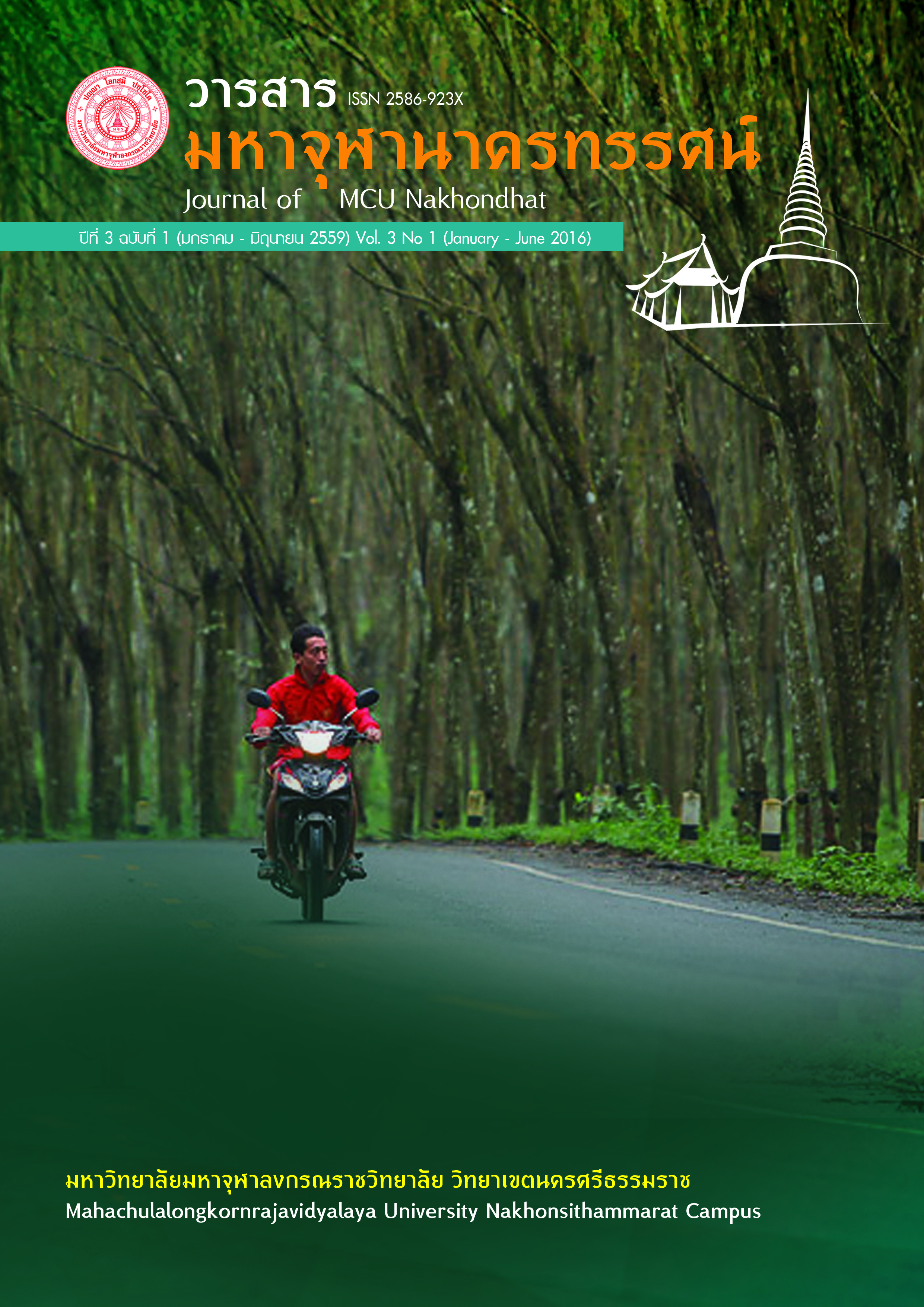SELF – PERFORMANCE ACCORDING TO SANGAHAVATHU PRINCIPLE OF MERCHANTS IN HAD PATONG, KATHU DISTRICT, PHUKET PROVINCE.
Main Article Content
Abstract
The objectives of this thematic paper were as follows 1) To study self – performance according to Sangaha Vatthu principle of merchants in Had Patong, Kathu district, Phuket province. 2) To compare self – performance according to Sangaha Vatthu principle of merchants in Had Patong, Kathu district, Phuket province in terms of sexes, ages, degrees of education, and monthly in comes as differently. 3) To study the suggestions were concerned with the way to promote self – performance according to Sangaha Vatthu principle of merchants in Had Patong, Kathu district, Phuket province. The population were merchants in Had Patong, Kathu district, Phuket province amount 795 persons, sample size according to table comparing of Krejcie and Morgan, the samples were amount 254 persons, the instrument for data collection was questionnaire bath closed and open end questions, data analysis by package computer program, the statistics were applied as follows, frequency, percentage, arithmetic mean, standard deviation, t-test, F-test and to test the difference of arithmetic mean in each pair by LSD. method.
The research results were found as follows.
1) Self – performance according to Sangaha Vatthu principle of merchants in Had Patong, Kathu district, Phuket province by overview was at moderate level when considered in each aspect form more to less found that the aspect of Piyavaja was the highest average, and followed up the aspect of Atthajariya and the as pact of Dana was the lowest average respectively, classified in terms of sexes, ages, degrees of education, and monthly incomes found that by overview was at more level.
2) The comparative results of Self – performance according to Sangaha Vatthu principle of merchants in Had Patong, Kathu district, Phuket province in terms of sexes, ages, degrees of education, and monthly incomes found that there were not different as statistical significance at .05
3) The suggestions were concerned with the way to promote self – perform ance according to Sangaha Vatthu principle of merchants in Had Patong, Kathu district, Phuket province found that the highest frequency was the aspect of Dana (Charity) i.e. there should be given more than the present. There should have introduced on Dana and the objectives. There should have promoted each others on Dana. There should introduce the new merchants.
Article Details
References
จิตต์ทวี จาตุรันต์. “การศึกษาการนำหลักพุทธธรรมไปใช้ในการประกอบการของธุรกิจอุตสาหกรรมขนาดย่อมในเขตกรุงเทพฯ และปริมณฑล”. วิทยานิพนธ์ครุศาสตร์อุตสาหกรรมมหาบัณฑิต. บัณฑิตวิทยาลัย : มหาวิทยาลัยเทคโนโลยีพระจอมเกล้าพระนครเหนือ, 2554.
จรูญ เจือจันทร์. “การดำเนินงานของคณะกรรมการกองทุนหมู่บ้านและชุมชนเมือง ตำบลแสนสุข อำเภอเมือง จังหวัดอุบลราชธานี”. วิทยานิพนธ์รัฐศาสตรมหาบัณฑิต. บัณฑิตวิทยาลัย : มหาวิทยาลัยมหาสารคาม, 2548.
ถาวร โพธิสมบัติ. “ปัจจัยที่มีผลกระทบต่อการให้บริการประชาชน : ศึกษาเฉพาะกรณีการให้บริการในเขตจังหวัดกาญจนบุรี”. วิทยานิพนธ์ปริญญาโท บัณฑิตวิทยาลัย : มหาวิทยาลัย ธรรมศาสตร์, 2535.
ประกอบ ยศเสถียร. “ปัญหาของเจ้าหน้าที่ในการให้บริการประชาชนในพื้นที่ชายแดน : กรณีศึกษาเปรียบเทียบอำเภอแม่จันและกิ่งอำเภอแม่ฟ้าหลวง จังหวัดเชียงราย”. วิทยานิพนธ์รัฐศาสตร์มหาบัณฑิตสาขาการเมืองการปกครอง บัณฑิตวิทยาลัย : มหาวิทยาลัยเชียงใหม่, 2536.
รุจิร์ ภู่สาระ. แบบเรียนแนวหน้าชุดพัฒนากระบวนการสร้างนิสัย. กรุงเทพมหานคร : อักษรเจริญทัศน์, 2541.
ส่งศรี ชมภูวงศ์. ระเบียบวิธีวิจัยทางสังคมศาสตร์. นครศรีธรรมราช : สำนักพิมพ์มหาวิทยาลัยมหามกุฏราชวิทยาลัย วิทยาเขตศรีธรรมาโศกราช, 2552.
สุชีพ ปุญญานุภาพ. พระไตรปิฎกฉบับประชาชน. พิมพ์ครั้งที่ 14. กรุงเทพมหานคร : โรงพิมพ์มหามกุฏราชวิทยาลัย, 2535.
ไสว มาลัยทอง. คู่มือการศึกษาจริยธรรมสำหรับนักเรียน นิสิต นักศึกษา นักการบริหาร ผู้ปกครองและประชาชนผู้สนใจทั่วไป. กลุ่มวิชาการพระพุทธศาสนา. กรุงเทพมหานคร : กระทรวงศึกษาธิการ, 2542.
มณีนุช ไพรดี. “การนำหลักสังคหวัตถุไปประยุกต์ใช้เพื่อสร้างความผูกพันต่อองค์กรของพนักงาน บริษัทพรอพเพอร์ตี้แคร์เซอร์วิสเซส(ประเทศไทย)”. วิทยานิพนธ์พุทธศาสตรมหาบัณฑิต.สาขาวิชารัฐประศาสนศาสตร์มหาวิทยาลัยมหาจุฬาลงกรณราชวิทยาลัย, 2553.
วลัยภรณ์ เขตสิทธิ์. “การปฏิบัติตนตามหลักสังคหวัตถุ 4 ของนักเรียนชั้นมัธยมศึกษาปีที่ 1 ปีการศึกษา 2550 โรงเรียนสันป่าตองวิทยาคม อำเภอสันป่าตอง จังหวัดเชียงใหม่”. สารนิพนธ์ศาสนศาสตรมหาบัณฑิต. บัณฑิตวิทยาลัย : มหาวิทยาลัยมหามกุฏราชวิทยาลัย, 2551,
อนันต์ แม้นพยัคฆ์. “การประยุกต์ใช้หลักพุทธธรรมเพื่อเสริมสร้างความเข้มแข็งของชุมชน ด้วยกลุ่มสัจจะออมทรัพย์ เพื่อพัฒนาคุณธรรมครบวงจรชีวิต กรณีศึกษา : บ้านหนองน้ำจืด ตำบลท่าพริก อำเภอเมือง จังหวัดตราด”. วิทยานิพนธ์พัฒนาชุมชนมหาบัณฑิต. บัณฑิตวิทยาลัย : มหาวิทยาลัยธรรมศาสตร์, 2549.
อรรถชล ทรัพย์ทวี, “ปัจจัยที่มีผลต่อทัศนคติในการให้บริการประชาชนของเจ้าหน้าที่ผู้ปฏิบัติงานทะเบียนราษฎร”. วิทยานิพนธ์ปริญญาศิลปศาสตรมหาบัณฑิต (สาขารัฐศาสตร์), บัณฑิตวิทยาลัยมหาวิทยาลัยรามคำแหง, 2547.


